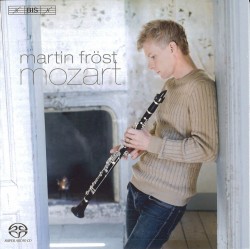 Mozart - Clarinet Concerto; Kegelstatt Trio; Allegretto
Mozart - Clarinet Concerto; Kegelstatt Trio; Allegretto
Martin Frost; Deutsche Kammerphilharmonie Bremen
BIS 1893
Clarinetist Martin Frost can play anything anyone puts in front of him. He’s that kind of monster. He can conduct and dance and who knows maybe serve toast and tea while doing so. He’s musical, he’s tall and Swedish, and he works with really good musicians on this release of Mozart works for the clarinet. So it’s heartening to this envious hack that even he can’t make me like the basset-clarinet, an ungainly extended clarinet with an out-of-proportion lower range that somehow makes me think of Jennifer Lopez.
It is the fashion to try to reproduce the lost or stolen manuscript version of the clarinet concerto K622 by revising the first edition such that certain passages make use of the extra four semitones at the bottom of the basset extension. To this ear that range is an ugly ostrich-ling, and the pitch wonkiness of a normal clarinet is exponentially worsened by the physical length of the lower joint.
Who besides Mozart wrote for the instrument? Franz Sussmeyer, that’s who. The guy who completed the scores of late Mozart works. After that… (deafening silence). Never mind, Frost is wonderful, his musicianship impeccable and the orchestra he leads is a flexible and united band. I say the rondo is too fast, but after that J Lo crack who’s listening?
Once you’ve enjoyed the concerto, hit pause and let things settle a bit before you jump into the Kegelstadtt Trio K498. The jump in key from A major to E-flat is likely an unintended jolt; some might like aural palate cleanser before continuing. Too rarely-recorded, the trio is a genial conversation. Written for his buddy Anton Stadler, like the quintet and the concerto, Mozart’s trio is named for the hangout where he may have spent many a dissolute hour: a bowling alley. He wrote the piano part no doubt to test a favoured student; it is a mini-concerto for the keyboard, especially the final rondo. The group makes interesting decisions regarding a problem posed by the piece: how to vary the pulse from one movement to the next. Their sense of ensemble is fantastic. The final selection is a reconstruction by Robert Levin of a fragment (93 bars) of a work Mozart began for clarinet and string quartet: a welcome addition to the chamber rep for clarinetists, and a terrific vehicle for Frost’s virtuosity, it’s full of lovely late-Mozartian surprises and innovation.



